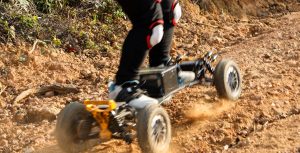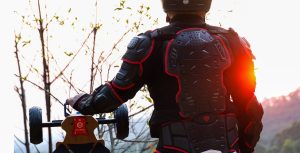Electric skateboards have advanced significantly over the past few years, with motor technology playing a central role in performance and ride quality. Among the most important components are the drive systems, specifically hub motors and planetary gear drives—each with distinct strengths and trade-offs.
Choosing between the two is an issue of riding style, terrain, and performance goal. We present here the core differences among hub motors and planetary gear drives and explain how each affects acceleration, torque, efficiency, and ride quality across riders.
Understanding Hub Motors
A hub motor is a through-drive motor in which the stator (permanent coils) is mounted on the truck, and the rotor (outer casing) glides within the wheel. The flow of current through the coils, when run through them, generates a magnetic field that turns the wheel directly.
But what are the pros and cons of the hub motors?
Key Advantages of Hub Motors
- Slimmer and Lighter:
Since the motor is integrated into the wheel, hub motors are thin in design with fewer external gears.
- Less Maintenance
Since there are no pulleys, belts, or gears, there are fewer wear-and-tear parts to be replaced.
- Less Noise
Hub motors are probably quieter than gear or belt-driven systems since they are direct drive.
- Water and Dust Protection
Sealed design offers more protection from weather conditions such as rain, mud, and dust.
Drawbacks of Hub Motors
- Low Torque Generation
Direct drive setups lack mechanical advantage, limiting their ability to generate high torque.
- Insufficient Shock Absorption
The motorized hub center removes space for traditional urethane thickness, making the ride on rough roads harsher.
- Lower Heat Dissipation Efficiency
Hub motors, enclosed within the wheel, have restricted airflow, which can cause overheating under sustained high loads.
Applications of Hub Motors
Hub motors are utilized most frequently in:
- Low-profile, stealth-type city-commuting electric skateboards.
- Light-duty and portable versions that emphasize convenience and easy transport.
- Low-cost electric skateboards that prioritize cost-friendliness versus minimalist torque output performance.
Understanding Planetary Gear Drives
Planetary gear drives are engineered for power and efficiency. They use a compact gear system to multiply torque and optimize motor output—ideal for demanding terrain and high-performance riding.
There are three fundamental components of a planetary gear drive:
- Sun Gear: The sun gear fixed inside the motor shaft.
- Planet Gears: The smaller gears that rotate about the sun gear, distributing torque.
- Ring Gear: The outer gear meshing with planet gears and providing power to the wheel.
Like hub motors, planetary gear drives have advantages and disadvantages:
Advantages of Planetary Gear Drives
- Improved Torque Multiplication
Planetary gear drives utilize a reduction ratio (typically 3:1 or higher), multiplying motor torque for enhanced acceleration and hill-climbing performance
- Increased Power Efficiency
Planetary gear drives minimize energy loss and maximize overall efficiency by optimizing motor RPMs and torque balance.
- Better Shock Absorption and Ride Quality
Since the motor is on the outside, wheels with larger diameters and higher urethane can be used for better damping of vibrations.
- Longer Life
Steel gears of higher quality provide a longer life cycle than direct-drive wheel motors, which are subject to internal stress.
Drawbacks of Planetary Gear Drives
- Requires More Maintenance
Greasing of gears and regular checks are required to provide maximum performance.
- Louder Operation
Gear drives are louder than hub motors due to the interaction of moving components.
- Slightly Higher Energy Consumption
Despite high efficiency, planetary gear drives experience slight frictional losses due to mechanical gear engagement.
Applications of Planetary Gear Drives
Planetary gear drives are best applied to:
- All-terrain electric skateboards requiring strong torque and hill-climbing ability.
- High-performance electric skateboards for high speed and responsive acceleration.
- Long-range riding, with maximum energy usage maximizing battery life and overall range per charge.
Performance Comparison and Real-World Benefits
After understanding these two motor systems, it’s time to compare their performance in detail and find out why planetary gear drives excel:
Torque and Acceleration
| Feature | Hub Motors | Planetary Gear Drives |
| Torque Output | Low, limited climbing ability | High, up to 3x torque with gear reduction |
| Acceleration | Moderate, slower from standstill | Fast, responsive even under load |
Insight: Hub motors are suitable for flat city streets but lack the torque for demanding situations. Planetary gear systems deliver superior torque and quick throttle response — crucial for hill climbs and rapid launches.
Energy Efficiency and Battery Usage
| Feature | Hub Motors | Planetary Gear Drives |
| Power Efficiency | Lower, less optimal torque curve | Higher, optimized RPM-to-torque balance |
| Battery Drain | Faster under stress | Slower and more consistent over long rides |
| Heat Dissipation | Limited (internal motor heat buildup) | Improved (external setup cools more effectively) |
Insight: While hub motors may seem efficient at low output, planetary gear drives are optimized for real-world riding, offering greater range and thermal stability over longer, tougher rides.
Ride Comfort and Terrain Handling
| Feature | Hub Motors | Planetary Gear Drives |
| Shock Absorption | Limited (thin urethane wheels) | Superior (full-size wheels, better damping) |
| Terrain Compatibility | Best on smooth pavement | Handles pavement, trails, gravel, and more |
Insight: Hub motors provide a smooth ride on perfect asphalt but struggle on bumps and cracks. Planetary gear drives allow for larger, softer wheels — resulting in a smoother ride across all terrain types.
Adaptability and Application Fit
| Riding Scenario | Best Fit |
| Daily urban commute | Hub Motor |
| Steep hills and inclines | Planetary Gear Drive |
| Off-road and mixed surfaces | Planetary Gear Drive |
| Lightweight, portable setup | Hub Motor |
| Long-distance trail riding | Planetary Gear Drive |
| High-speed, responsive control | Planetary Gear Drive |
Insight: Hub motors work well for lightweight commuters on smooth roads. For riders needing torque, traction, and versatility, planetary gear drives offer unmatched adaptability.
Considerations When Selecting a Drive System
Select Hub Motors If:
- You are concerned with minimal maintenance and minimalist design.
- You spend most of your time on smooth pavement.
- You want a silent and light skateboard.
Select Planetary Gear Drives If:
- You need high torque to climb hills, accelerate, or ride off-road.
- You want greater range and economy for long rides.
- You want a more durable and versatile drivetrain.
Which System is Right for You?
Hub motors and planetary gear drives both have their place in electric skateboard motor tech. If you’re a city commuter who wants simplicity and ease of use, hub motors provide an excellent ride. However, if you want torque, efficiency, and long-term reliability, planetary gear drives give you more torque, greater range, and greater versatility for mixed terrain.
At Ecomobl, we’re committed to gear drive electric skateboard systems that set a new standard for performance. Whether you need off-road performance or high-speed urban riding, our planetary gear technology delivers the efficiency and reliability serious riders expect.
Ready to ride smarter? Explore our full lineup of gear-driven electric skateboards and power your ride beyond the pavement.







